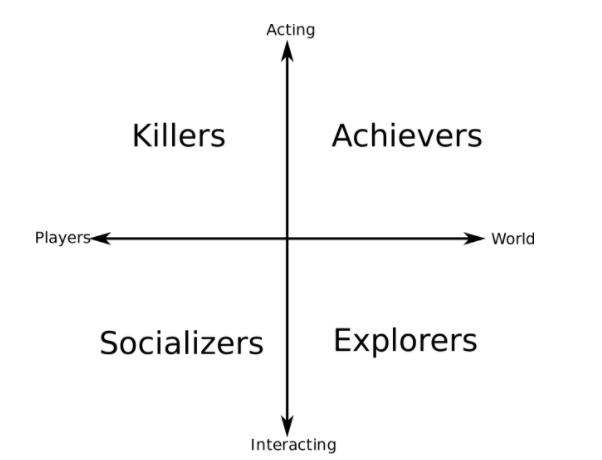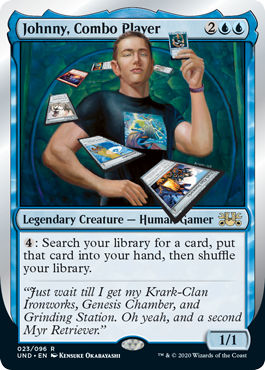Photo by Enrique Guzmán Egas on Unsplash
We all have our own unique motivations for playing games. Maybe you play games to make friends and meet new people. Maybe you play games to get immersed in exciting new worlds. Or maybe you play games cause you like making things explode. Whatever your motivations may be, as designers its our job to make sure that all types of players are engaged with our games. But what are the different player types, and how can we make sure that all of them are having fun? Let’s take a look at the many different ways of classifying players and see what we can discover.
Bartle’s Taxonomy
The most popular way of classifying players is Bartle’s Taxonomy of Player Types. Originally created to describe the players of online multiplayer games (specifically MUDs), Bartle broke players down into four main categories: Achievers, Explorers, Socializers, and Killers.
Bartle’s Taxonomy of Player Types
Achievers are motivated by acting on the game world. They care about accomplishing goals, both those set by the game and by themselves. They want to accumulate loot, unlock achievements, and just overall succeed at the game. These are the kinds of players that want to be challenged, and that want to prove to themselves how skilled they are at the game.
Explorers are motivated by interacting with the game world. They seek to understand how the game works and to uncover all of it’s secrets. They want to gain mastery over the game’s systems and push those systems to their limits. These are the kinds of players that love discovering new areas, unlocking hidden content, and uncovering weird glitches and easter eggs.
Socializers are motivated by interacting with other players. They love working together, roleplaying unique characters, sharing cool stories, and overall just hanging out and having a good time. For Socializers, it’s less about playing the game itself and more about using the game as a way to bond with their friends.
Killers are motivated by acting on other players. They are your classic competitive players. These players want to be the best, and they want everyone else to know how awesome they are. They care about defeating their enemies, climbing leaderboards, and asserting their dominance over other players. Sometimes Killers get a bad rep as trolls or griefers, but a lot of them are just looking for recognition.
While Bartle’s Taxonomy is a great baseline, it does have some limitations. It’s not the most comprehensive way of classifying players, and it sets up a bit of a false dichotomy between player types (e.g. Achievers and Socializers are supposed to be opposites, but there are plenty of players that would fall into both types). With that in mind, let’s examine another system that was directly inspired by Bartle’s Taxonomy.
Motivations of Play in MMORPGs
Taking a more deliberate and scientific approach, Nick Yee sought to break down why people play MMORPGs. They found that player motivation fell under three main components, Achievement, Social, and Immersion, each with their own set of sub components.
The Achievement component is all about mastering the game and becoming more skilled at it. These players are motivated by Advancement (e.g. reaching goals, leveling up, accumulating resources), Mechanics (e.g. understanding the game’s systems, optimizing their strategies), and Competition (e.g. beating and dominating other players, griefing, climbing leaderboards).
The Social component is all about connecting with others and working together. These players are motivated by Socializing (e.g. meeting new people, forming guilds, interacting with other players), Relationships (e.g. having meaningful conversations, supporting other players, strengthening friendships), and Teamwork (e.g. collaborating with other players, accomplishing group achievements).
The Immersion component is all about being invested in the game and getting lost in its world. These players are motivated by Discovery (e.g. finding new locations, collecting rare items, exploring the game world), Role-Playing (e.g. reading lore, integrating their character into the game’s world, experiencing deep or meaningful narratives), Customization (e.g. modifying their character’s appearance, crafting unique strategies), and Escapism (e.g. relaxing and relieving stress, avoiding their real-life problems).
I personally really like this model. I especially love how the motivations are non-exclusionary, meaning players could be motivated by both Social and Immersion rather than either/or. On top of that, scoring low in one of the components says just as much about you as scoring high. For example, a low Social score would mean you don’t like playing with other players and would rather play solo.
While the last two models have been focused on games in general, there are some models that are a bit more game-specific. Let’s take a look at one designed all around Magic: the Gathering.
Timmy, Johnny, & Spike
Timmy, Johnny, and Spike are psychographic profiles used for describing Magic: the Gathering players. They are useful for understanding why people want to play Magic, what makes different players happy, and what kind of experience they are looking for.
Timmy plays to experience something. Timmies are all about the journey, not the destination. They are looking for cool, flashy, and memorable moments. For Timmy it’s not about winning or losing, it’s about having a good time.
Johnny plays to express something. For Johnnies, the game is just an opportunity to show the world something about themselves. They like pulling off clever combos and showcasing their creative deckbuilding skills.
Spike plays to prove something. Usually, they are trying to prove how good they are at the game. Their #1 goal is winning and showing everyone what they are capable of. For Spikes, anything less than success is an unacceptable failure.
It’s worth noting that players can fall under multiple profiles (for example, I’m personally a Timmy/Johnny). While these profiles were designed specifically around Magic: the Gathering, I found they can apply to a lot of other games too.
For our last model, let’s focus on something a little more genre-specific…
Laws’ RPG Player Types
As outlined in their book, Robin’s Laws of Good Game Mastering, Robin Law divided RPG players into seven different archetypes. While these archetypes are pretty centered around RPG games like Dungeons & Dragons, they are still applicable to other game genres.
The Power Gamer just wants to make their character as strong, rich, and powerful as possible. They view their character as a collection of abilities optimized for obtaining even more abilities.
The Butt-Kicker uses the game as a way to blow off steam. They don’t really care about playing optimally so long as they get to hit things really hard.
The Tactician is looking to solve complex, realistic problems. They want their games to have clear, consistent rules so that they can execute their perfect strategies.
The Specialist always plays the same kind of character in every game they play. They want the rules to support their favoured character type, and are otherwise indifferent to them.
The Method Actor views the game as the a medium for personal expression. They like assuming the role of a character and embedding themselves into the game world.
The Storyteller, like the Method Actor, is also more inclined to roleplaying. The distinction is that the Storyteller cares about the narrative happening around them rather than their personal role in the story. They are quick to compromise if it moves the story forward, and get bored when the game slows down too much.
The Casual Gamer is often low key and uncomfortable taking center stage. While they may not be as overtly invested in playing the game specifically, they are still invested in being at the table and hanging out with the group. They aren’t here for the game, rather the game just happens to be the activity the group is doing.
So we’ve gone through four different ways of classifying players. While they share a lot of similarities, each one comes with its own unique strengths and weaknesses. So which one should you use? Which model is the perfect model for classifying players?
Answer: None of them, but also all of them?
Asking which model is the “correct” model isn’t really the right question. Rather, what you should focus on is the core concept they are collectively trying to demonstrate: players are different, and are interested in different things. You can use whatever model you want (I personally like using Bartle’s and MtG’s), but regardless of what model you choose players will fall between the cracks. As a designer, your role is to fill your game with things that will appeal to as many different player types as possible (however you choose to define those types). It’s fine to cater to a core niche, but even a niche is going to be full of players with diverse motivations for playing your game. At the end of the day, focus on what experiences your players want to have and what experiences you want to give them. Then, combine those experiences together to give your players something truly memorable.






